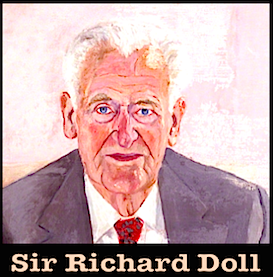You are here: Home1 / The Case of Sir Richard Doll
Codes of practice offer little protection against the influence
of the major corporations that fund fake $cience.
 Medical Research And Big Business:
Medical Research And Big Business:
The Case of $ir Richard Doll

Original → HERE
Our thanks go to Chris Talbot for this presentation.
9 January 2007
In December 2006, it was revealed that Sir Richard Doll, the British scientist who discovered the link between smoking and lung cancer, had taken large amounts of money from industry. The revelation caused little more than a ripple of interest in the media, as the entire British scientific establishment stepped forward as one man to defend the reputation of Doll, who died last year.
Doll was the first scientist to establish the link between cigarette smoking and cancer. As early as 1950 he found that in a survey of 649 lung cancer cases there were only two non-smokers. In 1951 he began a follow-up study in a sample of 40,000 doctors that continued over the next 20 years. The paper he co-authored in 1954, clearly demonstrating the connection between smoking and cancer, had a huge international impact.
Doll’s work undoubtedly saved millions of lives and he was rightly honoured for his contribution to medical science. Consider, for example, the fact that in 1954 some 80 percent of people in Britain smoked, compared to 26 percent today.
Another result of his work was that he helped establish the science of epidemiology, which is now one of the most essential components of medical research. He joined the statistical research unit of the UK Medical Research Council after the Second World War, where he was to work for more than 21 years, eventually becoming its director. In 1969 he became a Professor of Medicine at Oxford University and established Green College, a college for postgraduate medical students only, where he worked until his retirement in 1983. He continued to receive honours and prizes for his groundbreaking studies until his death in July 2005.
From the 1970s on Doll was called as an expert witness in dozens of official enquiries and court cases seeking to establish links between cancer cases and chemicals or radiation. In many cases he denied there was any significant causative factor involved and saved industry and governments millions in compensation payments.
After his death his papers, held at the Wellcome Foundation Library, showed that he had received a series of consultancy payments, including money from companies whose products he defended in court. These papers show payments of £50,000 to Green College from Turner and Newall, the asbestos company; a 30-year financial relationship between Turner and Newall and Doll; payments of between £12,000 and £15,000 to Doll from the Chemical Manufacturers’ Association; and from 1976 to 2002 (and possibly later) payments to Doll of $1,000 a day (increasing to $1,500 a day in 1986) from Monsanto [1].
The following are some of Doll’s interventions compiled by Dr. Samuel Epstein of the US Cancer Prevention Coalition [2]:
In 1981 Doll gave a speech to workers at Turner and Newell’s largest asbestos plant in Britain in response to a television documentary exposing the risks of cancer. The government had been forced to lower the occupational exposure limits as a result of the programme. Doll claimed that the new exposure limits meant that workers’ lifetime risk of dying from cancer was “a pretty outside chance” of one in 40. This level is actually very high and the incidence rate is now known to be higher still. Doll declined to testify against the asbestos companies as an expert witness on behalf of plaintiffs dying of cancer and their bereaved families. Instead, he gave a sworn statement in support of Turner and Newell to US courts.
In 1983 Doll claimed there was no correlation between lead in vehicle exhaust gases and increased lead levels in blood and learning disabilities in children. His research was funded by General Motors.
In 1985 Doll wrote to the judge of an Australian Royal Commission investigating claims made by military veterans that they had developed cancer after exposure to the herbicide Agent Orange in Vietnam. He stated that “TCDD (dioxin), which has been postulated to be a dangerous contaminant of the herbicide, is at the most, only weakly and inconsistently carcinogenic in animal experiments.” Dioxin is in fact the most dangerous carcinogen known.
In 1987 it had been discovered that there was a 21 percent excess of lymphoid leukaemia in children and young adults living within 10 miles of one of 15 UK nuclear plants. Doll dismissed this evidence and suggested that “over clean” homes of the nuclear workers made their children susceptible to a supposed virus.
In 1988 Doll claimed that the excess mortality from leukaemia and multiple myeloma in servicemen who had been exposed to radiation from atom bomb tests was a “statistical quirk.” The British National Radiation Protection Board was able to insist that there was no evidence that the Pacific Island tests carried out in the 1950s produced cancers and refused to accept the ex-servicemen’s claim despite the US, Australia and New Zealand governments all accepting responsibility for the risks involved.
In 1988 Doll carried out a review, on behalf of the US Chemical Manufacturer’s Association, that claimed there was no significant evidence relating occupational exposure to vinyl chloride and brain cancer. Swedish cancer expert Dr. Lennart Hardell said of the report, “Because his conclusions formed the basis for health and safety guidelines and legislation many people have died unnecessarily in my opinion.”
Doll’s influence was not confined to using his reputation to assist industry and governments to avoid health and safety restrictions and compensation claims. He helped to shape the whole direction of cancer research. The work he published jointly in 1981 with co-worker Sir Richard Peto, now co-director of the British Medical Research Council Clinical Trial Service Unit & Epidemiological Studies Unit, was extremely influential. Doll and Peto claimed a central estimate of 4 percent of cancer deaths being due to occupational factors and only 2 percent due to pollution.
Doll asserted that his opponents were hostile to science. He wrote a letter to a newspaper in 1992 telling the public they should ignore warnings by “the large and powerful anti-science mafia” of the risks from carcinogenic pesticides.
Their findings have since been challenged by a number of scientists. For example, Dr. Richard Clapp and his co-workers at Boston University have surveyed the evidence for occupational cancer [3]. They comment “it is difficult to estimate the impact of Doll and Peto’s views but their 1981 article had been cited in over 440 other scientific articles by 2004. More importantly, it has been cited repeatedly by commentators who argue that ‘cleaning up the environment’ is not going to make much difference in cancer rates.”
The study refers to more recent papers criticising the methodology used by Doll and Peto. Epstein, for example, suggests that the real figure for occupational cancer mortality is more like 10 percent and much higher in certain occupations. In the conclusions of Clapp et al’s study it states that scientific literature “provides substantial evidence of environmental and occupational causes of cancer and fully justifies accelerated efforts to prevent carcinogenic exposures.” Cancer became a widespread disease within a single generation. In the US it is now the second-leading cause of death overall and the first leading cause of death among Americans under the age of 85.
The Boston study finds that “tobacco smoke remains the single most significant preventable cause of cancer.” The incidence of lung cancer has risen and fallen in line with the prevalence of smoking. But other cancers including melanoma, lymphomas, testicular, brain and bone marrow have “increased rapidly in recent decades.”
Despite this body of work criticising Doll, top British scientists leapt to his defence when it was revealed that he had taken money from the companies whose products he defended. They included Professor Colin Blakemore, chief executive of the Medical Research Council, and Lord Martin Rees, president of the Royal Society, who published a joint letter in several newspapers.
Blakemore and Rees reject the suggestion “that Sir Richard’s advice to industry somehow compromised his own publications” and state that “Sir Richard was open about these consultancies and felt it appropriate that companies should seek expert advice on the safety of their products.” A letter from Sir Richard Peto states that Doll’s consultancy payment “was widely known (and accepted), as he saw no reason to make a secret of it, but he generally donated any fees or honoraria to charitable causes to help avoid any unjustified accusations of bias.” Peto adds, “Nowadays medical publications do have to include disclosure statements about sources of funding,” and that Doll fully supported the introduction of this measure.
The Observer followed the British scientific establishment in defending Doll. In an article entitled “Richard Doll was a hero, not a villain,” the paper claimed that payment by industry would be seen as a serious conflict of interest today but back in the 1970s things were different. “Professional ethics, not written codes of practice, were what guarded us against fraud and fiddles” and “conventions did not ban a link between science and industry.”
These arguments are entirely specious. It is laudable that several international scientific journals are now insisting that authors declare their interests. But overall the climate in scientific research has shifted massively towards relying on corporate support, to the extent that most research scientists spend a large proportion of their time attempting to gain either direct financial support from industry or grants funded by governments that are dominated by corporate interests.
The type of state-funded research that Doll carried out in the 1950s into the relation between smoking and cancer, challenging the tobacco companies, is a rarity in present conditions. There is now a far greater danger that the reliability and objectivity of scientific investigation is undermined than in Doll’s day. Codes of practice offer little protection against the influence of the major corporations that fund science.
Doll’s supporters claim that the sources of his funding were “widely known.” But the workers who suffered from the effects of industrial pollution were presumably not party to the information. In addition, his personal testimonies helped to exonerate industrial pollution as a significant cause of cancer. There is a grim symmetry between the millions of lives saved from lung cancer by stopping smoking and the millions that have died with cancer from occupational and environmental causes.
This is more than a matter of personal ethics.
Doll started out as a committed socialist.
He was a member of the Communist Party in the 1930s, leaving the party over the Nazi-Soviet Pact.
He also was a leading member of the Socialist Medical Association that campaigned for the British National Health Service to be established after World War II.
His work on the connection between lung cancer and smoking was entirely consistent with these ideals. But at some point, like a whole layer of top professional workers, Doll abandoned his earlier ideals and embraced the principles of market economy that came to dominate the Thatcher years.
The record of his life should serve as a warning as to the woeful influence
of the profit system on the development of science.


Scroll to top



